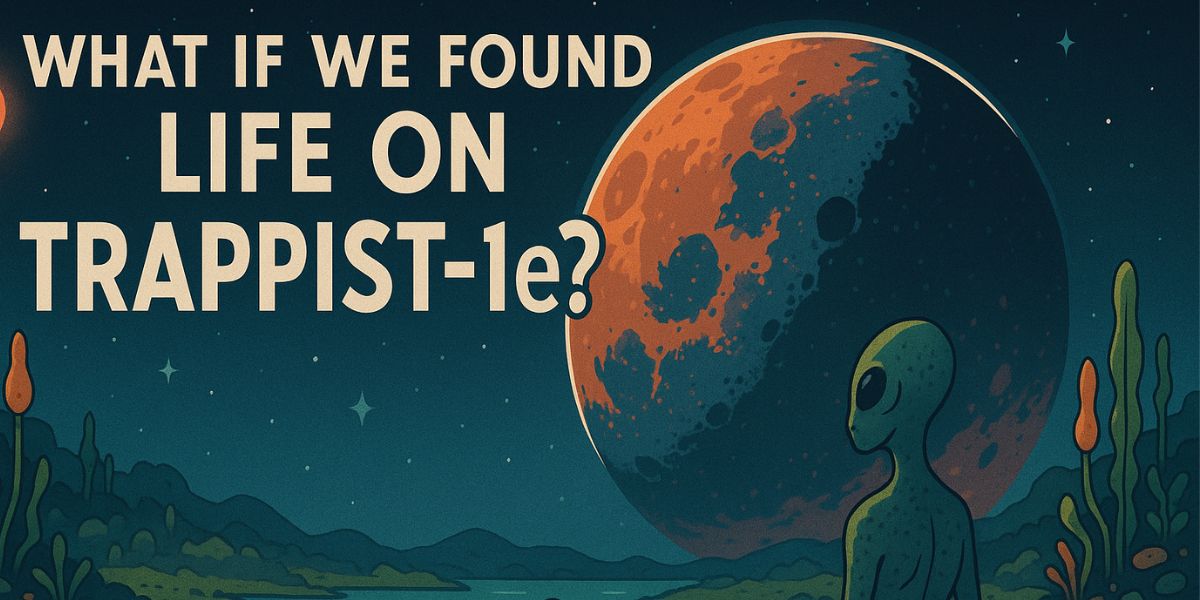Imagine looking up at the night sky and seeing not just stars, but planets where life might exist. One such planet is TRAPPIST-1e, a world 40 light-years away from Earth. Scientists think it could have water, air, and maybe even life!
TRAPPIST-1e is part of a system with seven Earth-sized planets. They all orbit a small, cool star called TRAPPIST-1. Because this planet is in the “habitable zone,” where temperatures are just right for liquid water, it’s one of the best places to search for alien life.
What would happen if we discovered living things there? Would they look like us, or be something completely different?
What Is TRAPPIST-1e?
TRAPPIST-1e is a rocky planet, about the same size as Earth. It orbits a tiny, dim star much smaller and cooler than our Sun. Because the star is weak, the planet must stay very close to it to stay warm.
- Distance from Earth: 40 light-years (very far, but one of the closest possible habitable worlds).
- Size: Almost the same as Earth.
- Temperature: Could be just right for liquid water.
Scientists study this planet using telescopes like JWST (James Webb Space Telescope) to check its air and surface for signs of life.
Could TRAPPIST-1e Have Liquid Water?
Water is essential for life as we know it. TRAPPIST-1e is in the perfect spot—not too hot, not too cold—where water could stay liquid.
- If the planet has an atmosphere, it might trap heat and keep water from freezing.
- Some scientists think it could have oceans, while others believe it might be dry.
- Future missions may look for clouds or glaciers as proof of water.
Finding water would be a huge clue that life might exist there!
What Kind of Life Could Exist on TRAPPIST-1e?
If life exists, it might be very different from Earth’s. Here are some possibilities:
- Microbes: Tiny life forms like bacteria could survive underground or in water.
- Plants: If the planet gets enough light, alien plants might grow.
- Strange Animals: Creatures could evolve in ways we can’t imagine!
Since the star is dim, any plants might be black or purple to absorb more light. Animals might have big eyes to see in low light.
How Would We Communicate with Aliens on TRAPPIST-1e?
If we find intelligent life, talking to them won’t be easy.
- Distance Problem: A message sent today would take 40 years to reach them!
- Language Barrier: They might not understand our words or signals.
- Technology: We’d need super-advanced tools to send and receive messages.
Scientists might use math or light signals since numbers are universal.
What Would Happen If We Found Life?
Finding life on TRAPPIST-1e would change everything!
- Science: We’d learn life can exist outside Earth.
- Religion & Philosophy: People would rethink humanity’s place in the universe.
- Space Travel: Missions to TRAPPIST-1e might become a top priority.
Would we try to visit? With today’s tech, it’s impossible—but maybe in the future!
Could Humans Live on TRAPPIST-1e?
Right now, no. The journey would take thousands of years, and we don’t know if the air is safe. But if we could:
- The gravity is like Earth’s, so walking would feel normal.
- The dim star means the sky might always look like sunset.
- We’d need strong shelters to protect from space radiation.
Maybe one day, humans will live there—but not yet!
Conclusion
TRAPPIST-1e is one of the most exciting places to search for alien life. If we find even tiny microbes, it would prove we’re not alone in the universe. Scientists keep studying this distant world, hoping for answers.
What do you think? Would aliens on TRAPPIST-1e look like us, or be something totally strange?
How far away is TRAPPIST-1e?
TRAPPIST-1e is 40 light-years from Earth. That means light from this planet takes 40 years to reach us!
Does TRAPPIST-1e have oxygen?
We don’t know yet. Scientists are using telescopes to check if its air has oxygen, which could mean life.
Can we see TRAPPIST-1e from Earth?
No, it’s too small and dim. Only powerful telescopes like JWST can study it.
Is TRAPPIST-1e hotter or colder than Earth?
It might be similar, but its star is much cooler, so the planet needs to stay close to stay warm.
How long would it take to travel to TRAPPIST-1e?
With current technology, thousands of years. We’d need much faster spaceships!
What star does TRAPPIST-1e orbit?
A tiny, cool star called TRAPPIST-1, much smaller than our Sun.
Could TRAPPIST-1e have oceans?
Maybe! If it has liquid water, oceans could exist. Scientists are still looking for proof.
Has NASA found life on TRAPPIST-1e?
Not yet, but NASA and other agencies are searching for signs.
Why is TRAPPIST-1e special?
It’s Earth-sized, in the habitable zone, and one of the best places to look for alien life.
What would aliens on TRAPPIST-1e look like?
Nobody knows! They might be microbes, plants, or creatures adapted to dim light.
